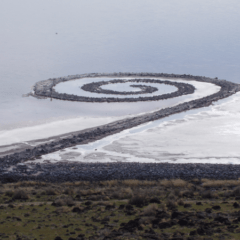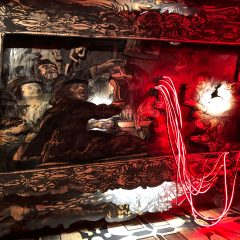—>Sam visits an empty lot in Point Breeze where artist Maria Moller has created a temporary elegy to the past and the people who once lived in a house no longer there. –the Artblog editors——————–>
The House That was Here
Within the tight grid of urban landscapes, vacant lots hold space that we rarely stop to consider. We take for granted these holes in the terrain, whether they are abandoned factories, polluted brownfields, or formerly residential pieces of land, and rarely ponder the stories they have to tell. But as part of an art project financed by the Philadelphia Redevelopment Authority, artist Maria Möller teamed up with local teens in South Philly to do just that, erecting on one parcel of vacant land, an ode to the human lives once lived there. As Möller put it in a press release accompanying the opening of her installation, The House That was Here, “Vacant lots are everywhere in Philadelphia. But I can’t think of any place where a house once stood as truly being vacant. Memories are there, the stories of the people who once lived there are there. The story of how the lot became vacant is there, as is the story of what happens to it afterwards.”
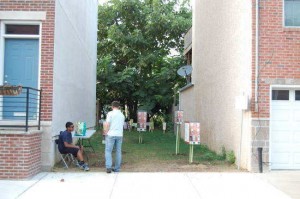
Möller’s project is located at 2025 Federal Street in the Point Breeze neighborhood of South Philadelphia, a lot that has been vacant for 50 years. Five miniature models of a typical row-house stand a few feet above the ground, each with the same picture of a house on the front side, and a picture of the towering tree at the back of the lot on the rear side. Text on the sides of four model houses tells the stories of the families that formerly lived on this location, based on city records that Möller found online. The fifth model house is reserved for designs made by community members visiting the site who participate in “open houses” at the installation site.
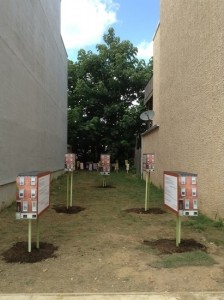
The ghosts of the site’s history
The theme of death weighs heavily on this installation at a site unoccupied since the 1960s when the original home was destroyed in a fire. Placards at the back are like tombstones in memory of the lives lived here in the building’s last two decades. Walking into the lot, you feel confined by the coffin-like space, closed off by the walls of row-homes on either side. The ground is uneven and bumpy with remnants of the former home, yet another ghostly reminder of the past. In the quiet of the vacant lot, you will inevitably begin to imagine the past lives of the families that lived in there.
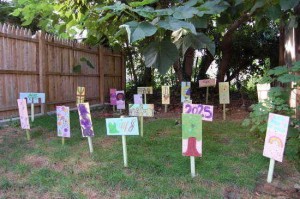
Möller created the project with the help of ten local teens. They helped with the construction, digging up parts of the lot to install the house-model stands. Deja Halder, 16, who was at the site when artblog visited, said that he found baby shoes among the debris. While Möller’s research indicated that 2025 Federal Street was built at some point between 1877 and 1879, there is no concrete record of the firebombing that neighbors told her destroyed the home almost ninety years later. But the artist and her group of teen artist-apprentices found their own evidence of the fire: numerous sections of buried charred wood. The ground was also full of rocks, causing teenage helper Markell Anderson to break a pick-axe while trying to dig up an especially large stone.
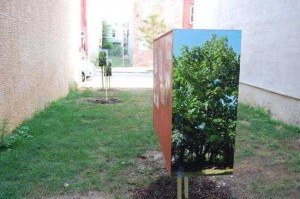
Perhaps due to the nature of the project being a group effort with local youth, aspects of the installation have a high-school art project vibe, rather than the machined precision of a professional artist’s work, but that’s not necessarily a bad thing, for, as a tribute to the past lives of South Philadelphians, Möller’s installation is a haunting experience.
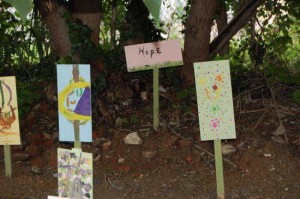
Who owns a neighborhood?
Point Breeze is also well-known as a flash point for conflict over gentrification in the area. A recent blurb in the Philadelphia City Paper detailed heated arguments that occurred on Facebook between a local anti-gentrification civic association and a developer vilified for his work in the neighborhood.
Möller’s project provides an interesting historical lens through which to contemplate the question of who owns a neighborhood. In this case, the records show a kaleidoscope of peoples moving in and out of 2025 Federal Street over the years, with groups of Irish and Italian immigrants recorded as occupying and leaving the block in droves within a few years of each other. In its first 20 years, 2025 Federal Street was occupied by tailors, tin-makers and cobblers. In 1898, Russian Jews moved in. In 1920, a black family moved in. With the house gone, no individual occupant has any greater claim on the land than any other – they all make up the legacy of this unique piece of land.
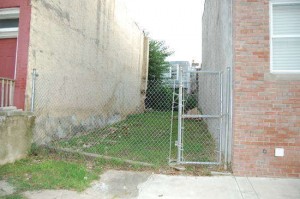
In one eerie detail peculiar to this location, another fenced-in vacant lot sits right across Federal Street from The House That Was Here. It is likely as haunted by ghosts as 2025 Federal Street is, but its history, like that of the many, many other untouched and untapped vacant lots around Philadelphia, remains to be explored.
The House That Was Here will be installed at 2025 Federal Street through through Tuesday, September 3. For more information about the project, visit thehousethatwashere.tumblr.com.


